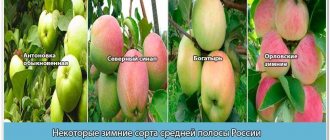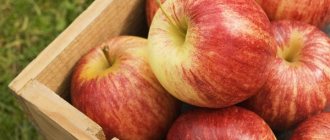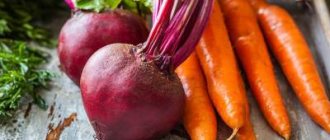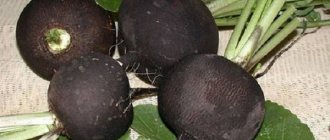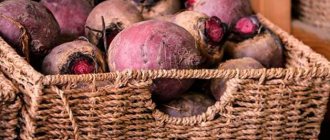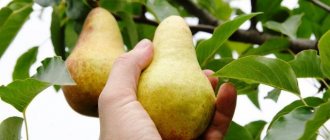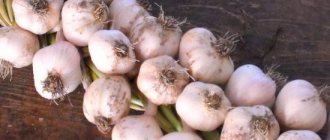Temperature and Humidity Requirements
How to store apples in the cellar in winter?
The ideal temperature for preserving these fruits can range from -1 to +3 degrees.
At this temperature, ethylene, which is released from apples, will not come out of the fruit as intensely, and the harvest will last much longer.
Optimal humidity : this indicator should be between 85–95%. This high percentage of humidity in the basement will keep the apples from drying out and shriveling.
Is it possible to store apples in the cellar?
The cellar is the best place for storage. Apples remain fresh for several months after harvest. The cellar must be prepared for storage: cleared of debris, ensure air circulation, favorable temperature and humidity.
Optimal temperature and humidity
The shelf life depends on the storage conditions. Apples emit ethylene gas during storage. It causes rapid ripening of fruits. It is necessary to reduce the ethylene content and select the optimal temperature and humidity. High humidity will protect the fruits from wrinkling and drying out. Apples stand well at a temperature of -1...+4° C, air humidity 85–95%.
Early varieties with thin skin can withstand higher temperatures.
When to store apples
Harvest time depends on the variety:
- winter varieties ripen in September-October, ripen during storage;
- summer species are harvested in July-August;
- autumn varieties - in August-September.
Winter and late-ripening species are left for long-term storage until spring.
After harvesting, low-quality specimens are rejected. The fruits are kept in the cold for 2–3 weeks to identify hidden defects. Then they are re-inspected and transferred for long-term storage to a cool place with ventilation, temperature -1...+4°.
There is a misconception that fruits should be immediately stored for winter storage.
How to prepare a cellar?
The cellar in which apples will be stored must meet the following requirements:
- The height of the room is 2.2–2.3 m, no less. If the cellar is lower, then condensation will appear on the ceiling, affecting the humidity and, ultimately, the duration of fruit storage.
- The floor in the cellar should be made of brick or dry boards. It should not be concreted.
- The walls of the room must be whitewashed with lime. If the basement is too damp, then you need to spread potassium chloride or fine lime; these substances will absorb unnecessary moisture.
- Before placing fruit in the basement, the room must be disinfected . To do this, apply a solution of components such as lime, copper sulfate and water to the walls (for 10 liters of liquid you need 1.5 kg of lime and approximately 150 g of vitriol). Namely: whiten the walls with freshly slaked lime (1.5 kg) with copper sulfate (150 g) and water (10 l).
- It is important to provide natural or forced ventilation .
Is it possible to freeze apples at home? The answer is in our article. Read about how to dry “substandard” apples here.
Simirenko apples. Renet Simirenko
| Renet Simirenko | |
| Taxonomy | |
| Genus | Apple tree |
| View | Homemade apple tree |
| Variety | 'Renet Simirenko' |
| Synonyms | |
| Green Renet Simirenko, Renet P. F. Simirenko | |
| Origin | |
| Country of origin | Mliev, Kyiv Governorate |
| Author | Simirenko Lev Platonovich |
| Originator | Mlievsky Research Institute of Forest-Steppe Horticulture of Ukraine named after L. P. Simirenko |
| Media files on Wikimedia Commons |
Beneficial and destructive proximity
How to store apples in the cellar in winter along with potatoes? You cannot save apples and potatoes . This is not necessary because apples emit ethylene , which, when it gets on the potatoes, causes harm , as a result of which the potatoes sprout . At the same time, apples acquire an unpleasant starchy taste and also ripen very quickly.
Also, apples should not be stored together with cabbage, onions or garlic . As a result of such proximity, apples will acquire an unpleasant smell and taste. In general, such fruits should not be saved together with vegetables.
A useful neighborhood for apples is pears .
These fruits feel comfortable when they are nearby. There is no unpleasant smell or aftertaste after such proximity.
Why are green potatoes dangerous?
Potatoes are the second most popular product in the kitchen after bread. It’s like a “lifesaver” when you need to quickly and satisfyingly feed your family. Agree that potatoes are eaten with gusto, both in the form of crispy pieces and in the form of fluffy puree. There are simply countless potato dishes. But are you always sure of the quality of raw materials?
Exposing fruits to open sunlight for a long time, and even at room temperature, leads to irreversible consequences. Why are potatoes green? The peel (the surface of the tubers) begins to change color and the vegetable becomes limp. In this form, potatoes are completely unsuitable for consumption.
The point is to increase the concentration of the substance solanine (melongene). This compound is found in all vegetables of the nightshade family (potatoes, tomatoes, eggplants, bell peppers, etc.). And the higher the degree of maturity of the fruit, the lower the concentration of the dangerous substance. A safe level is no more than 20 mg of solanine per 100 g of product.
How to prepare apples?
To store fruits for the winter, they need to be selected . You need to make sure that there are no dents, crushed places, or worms on the fruit. Apples should be selected those that have a stalk.
If any apple is left without it, it will soon begin to deteriorate due to fungal diseases . You also need to choose those fruits that still have a natural wax coating .
should be sorted by size and variety.
Small apples should be kept in a separate box from large and medium ones.
Such calibration is necessary because the presence of large apples, which emit large amounts of ethylene , together with small ones will contribute to faster ripening of small fruits.
Because of this, large apples will begin to deteriorate, which will ultimately lead to large harvest losses . It is also important to sort apples by variety. After all, different varieties of apples have individual shelf life. Therefore, you need to keep such unequal fruits in separate boxes.
You will learn how to properly sort apples for storage by watching this video:
Preparing apples for storage
The preparatory stage is extremely important to ensure good preservation of the apple harvest in the autumn-winter period. In order for the fruit to last until spring, it is necessary to carry out a number of preparatory measures.
Disinfection of a cellar or basement is a mandatory procedure. The walls of the room must be whitewashed with lime. All racks, shelves, drawers and other internal structures must be disinfected using specialized products (copper sulfate, Bordeaux mixture, etc.). If necessary, treatment against rodents and insect pests should be carried out.
What varieties of apples are suitable for storage?
Not all varieties of apples have the same shelf life and can be stored well for a long time. According to the ripening period, winter, autumn and early ripening summer varieties are distinguished. Early apples do not last long and spoil very quickly. Mid-season varieties can remain fresh for about 2-3 months.
Late-ripening varieties that remain juicy and tasty for 6-7 months are most suitable for winter storage in the cellar. The fruits are harvested slightly unripe, when they are still sour and hard. Over time, the fruits ripen and acquire sweetness. Such apples are distinguished by a dense and thick skin, which protects the fruit from drying out and infection. The following varieties are considered the most popular and popular among gardeners for winter preservation: Antonovka, Pepin saffron, Melba, Renet Simirenko, Jonathan, etc.
How to eat apples for storage?
The preservation of the taste characteristics and keeping quality of these fruits is determined by the skill of harvesting the fruits. They need to be picked not only in a timely manner, but also correctly. You should adhere to the main rules for harvesting apples:
- Work is carried out in clear, dry weather.
- First of all, collect the carrion (in a separate container). Such fruits are only suitable for processing.
- It is better to work with soft fabric gloves, trying not to disturb the natural protective wax coating on the fruit.
- The apples are picked carefully (rotating around their axis) along with the stalk.
- You should first collect fruits from the lower branches, then gradually rise higher.
- You can't throw fruit. They must be handled with care and caution to avoid accidental damage. Otherwise, the apples will quickly begin to spoil. All damaged specimens are set aside separately, as they are unsuitable for storage.
- The picked fruits are carefully placed in a wicker basket or plastic bucket. It is recommended to put a layer of straw or soft cloth at the bottom.
Immediately after harvesting, the harvest does not need to be transferred to the cellar. Experienced gardeners recommend leaving apples for 2-3 weeks in a cool room. During this time, existing defects and shortcomings will become clearer.
Fruit preparation
Before planting, the crop must be carefully sorted, discarding beaten, rotten, scratched and damaged specimens. Only smooth, healthy fruits with preserved stalks are selected. Apples of some varieties are separated from others, because they have different shelf life. One accidentally dropped early apple can greatly harm fruits that ripen later when they begin to rot in the box. All fruits are sorted by size. For winter maintenance, it is preferable to take fruits that have average parameters. It has been noticed that large apples are stored worse.
There are several ways to process fruits to increase disease resistance and extend shelf life:
- apples are coated with glycerin;
- immerse for 1 minute in a 4% calcium chloride solution;
- soak for 2-3 minutes in a weak solution of potassium permanganate;
- cover with wax, dipping one at a time into the composition melted in a water bath;
- treated with ultraviolet light for 20-30 minutes;
- dipped in propolis tincture (0.1 kg) with alcohol (0.5 l), heated to 45°C.
Before eating, such fruits must be thoroughly washed or skinned.
What container will be needed?
Containers for winter storage of apples can be varied, however, they must meet such basic requirements as strength and cleanliness .
How to store apples in the cellar? Most often, people store apples in the following containers:
- In wooden boxes . When choosing such a container, it is important to ensure that the upper drawers do not press down on the lower ones. Apples in wooden boxes cannot be filled to the top, otherwise the top layer of fruit will definitely suffer.
- In cardboard boxes . Such containers need to be properly taped to prevent the box from tearing.
- In lattice plastic chests . Since such containers have gaps, you need to lay paper on the bottom and sides of the chests and put apples on top.
- On the shelves . If the shelving in the basement has pull-out drawers, that’s generally excellent. This is a very convenient storage method that allows you to see the condition of the entire crop. Before placing apples in the basement, the racks must first be dried and covered with burlap or paper.
Storage Features
There are 3 stages of the storage period of this crop, each of which has its own characteristics:
Post-harvest period
Including a period of treatment and cooling. At this time, the dug up tubers are dried, ripen and damage is healed. After removing the potatoes from the ground, leave them in the beds for a couple of hours. During this time, the tubers are slightly dried. You should not leave them in the open rays of the sun for a long time, as the tubers can get burned. We transfer the vegetable harvest to a shaded and well-ventilated place and lay it in as thin a layer as possible. So we keep the potatoes for several days (up to 2 weeks). During this time, the tubers will acquire additional protective properties and heal damage to the skin and pulp by forming a dry skin on them. The healing process is best carried out at 13-18 degrees. In this case, the air humidity level should be about 90%. When the temperature drops, the wound healing process can last up to 3 weeks.
The process of cooling the tubers also plays an important role. So, while healing the damage, gradually cool the potatoes, bringing the temperature to 2-4 degrees. With such cooling, all physiological and biochemical processes in vegetable tubers are suspended. The ideal is to lower the temperature by 0.5 degrees per day, but since few summer residents can control this process in this way, we can only expect a natural drop in air temperature a couple of weeks after the harvesting period. Healing wounds and timely rejection of tubers affected by diseases and pests will increase the level of crop safety.
The main period is winter
When tubers overwinter in a dormant state. This period lasts until the beginning of spring
At this time, it is especially important to observe the storage regime. Each summer resident must carefully take care of the required temperature and humidity in the storage
The optimal temperature for effective preservation of potatoes is 2-4 degrees. With it, not only do all processes in the tubers slow down, but pathogenic microorganisms also do not multiply. At this temperature, the tuber eyes do not die off and remain healthy.
Maintaining optimal temperature
If the air temperature drops, which often happens in very cold winters, the potatoes may freeze. As a result of the fact that starch is converted into sugar, potatoes acquire a sweetish taste and abnormal consistency. Because of this, it becomes practically unfit for food and quickly rots. To prevent this, vegetables are covered with straw, warm blankets or clothes. At elevated temperatures, pathogenic microorganisms and rot quickly develop. To cool the air in the storage room, vents or vents should be opened regularly. To control the temperature in this room, there must always be an accurate thermometer.
Humidity matters too
The safety of the vegetable harvest largely depends on the correct level of humidity. It should be 85-90%. An increase in this indicator leads to the germination of tubers and their “sweating”, which often ends in the appearance of rot. With low humidity, tubers lose their elasticity (turgor), become sluggish, soft, and flabby. Any violation of the humidity level significantly reduces the shelf life of potatoes, so it must be regularly monitored according to the hygrometer readings. To increase humidity, you can spray water on the walls or hang a piece of damp cloth. You can lower the humidity level by regular ventilation, placing containers filled with quicklime, and covering the potatoes with bags of dry wood shavings.
Only in the dark
It is also necessary to consider the illumination of the storage area. When exposed to light, tubers produce the toxic substance solanine, which makes them unsuitable for use in the Pushcha. This process is indicated by the greening of the tubers. As a rule, this problem does not exist in dark cellars and basements, but when storing potatoes on insulated loggias and balconies, this problem should be prevented in advance. To do this, simply wrap the boxes with vegetables with thick fabric or shade them with plywood.
Which comes in February-April. During this time, the tubers come out of dormancy. When signs of their germination appear, it is necessary to reduce the temperature at night and in the morning. This is done by opening vents or windows. During this period, the air temperature should not exceed 1.5-2 degrees. Seed potatoes are transferred to a warm place for germination.
How to arrange fruits correctly?
It is desirable that each fruit is somehow separated from the rest.
To do this, you can try wrapping the apples individually in paper , or sprinkle them with sand and maple leaves .
If apples will be stored in boxes, then the fruits should be placed in rows and diagonally, and not just poured out. And if the apples will be stored on racks, then the fruits can be sprinkled with oiled shavings.
Saving apples in plastic films is also appropriate. In this case, apples should be placed like this: first, 2 layers of film are placed in the box, the first along the length, the second along the width of the box. Then the apples are laid in an even layer. Finally, the film is placed on top and covers the top layer of apples.
How to store apples at home? The answer is in our article. What varieties of apples are suitable for drying for compote? Find out now.
Read about preparing apples before drying here
Is it possible to store potatoes with other vegetables and fruits?
In order to preserve vegetables for the required period and prevent high rates of spoilage caused by improper storage conditions, the criteria for their compatibility in one box should be taken into account:
- the thickness of the integumentary tissue of a vegetable, root vegetable or fruit;
- identical requirements for temperature and humidity;
- substances secreted by the fetus.
Potatoes can be left to overwinter with vegetables that have the same long-term storage regime, do not emit substances that accelerate their germination and spoilage, and also absorb excess moisture or do not spoil due to its presence.
The fact is that in a box, barn or bag in the upper layers of potatoes, natural sweating of the tubers often occurs. To absorb the released moisture, root crops are needed that are close in requirements to storage conditions.
Attention!
No tricks will save your harvest if you send unripe potatoes, damaged tubers or an early ripening variety for a long time. In all these cases, it is necessary to frequently sort through the crop and remove soft tubers affected by rot from the storage area.
The best varieties of potatoes for winter storage
Potato varieties of mid-late and late ripening are best suited for winter storage - the duration of the dormant period approximately corresponds to the length of the growing season.
For harvesting root crops for the winter, it is important that the late varieties are the most delicious, have a high starch content and are rich in beneficial microelements.
The most popular potato varieties for winter storage (Middle zone and Moscow region)
| Variety and ripening period | Description of the variety | Descriptions of root vegetables |
| Picasso (late) | A productive variety of Dutch selection for the Moscow region and southern regions (up to 20 tubers in a nest), drought- and heat-resistant, rarely gets sick. | Oval beige root vegetables (from 100 g) with pink eyes. The pulp is creamy. |
| Zhuravinka (late) | An unpretentious variety of Belarusian selection, resistant to most potato diseases, including scab and late blight | Smooth tubers (from 100 g) with a red skin, the flesh when cut is yellow. |
| Asterix (late) | The Dutch selection variety is characterized by increased resistance to mechanical damage and long-term storage | Smooth root vegetables (about 100 g) with red skin and yellow flesh. |
| Lorch (mid-late) | A high-yielding variety with increased keeping quality of tubers, it is not afraid of late blight and cancer. | Large root vegetables (100-120 g) beige in color with white pulp. |
| Blueness (average) | An unusually productive (up to 500 kg per 1 acre) large-fruited variety, resistant to viruses and fungal diseases. | Large (from 150 g) smooth tubers of excellent taste, white in color with white pulp. |
We collect and select fruits
Harvesting is carried out on a fine day without rain or high humidity. In this case, it is better to wear gloves so as not to erase the natural waxy coating on the fruit.
Collection begins from the lower tiers of branches, gradually moving to the upper ones. The apple is carefully rolled, after which the stem is easily separated from the branch. It is better to put something soft in the basket for collecting fruits, and carefully lay the fruits on top, trying not to damage the skin.
Fruits that have fallen from an apple tree can also be collected, after which the spoiled ones can be separated from the good ones.
Only whole and healthy apples are suitable for storage - without rot, scratches, spots or damaged sides.
The main thing is that you should never wash or wipe fruit. Without natural protection, they will last much less.
During the first week, you will have to keep a close eye on the collected fruits: remove specimens that looked good when selected, but soon began to deteriorate.
